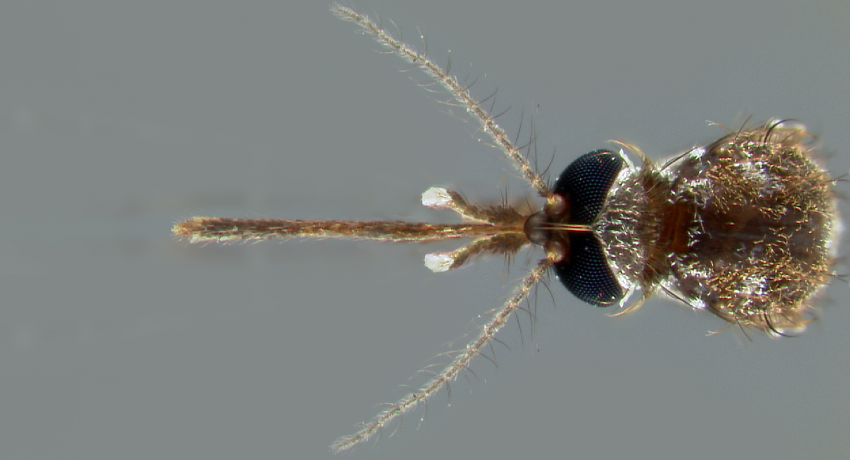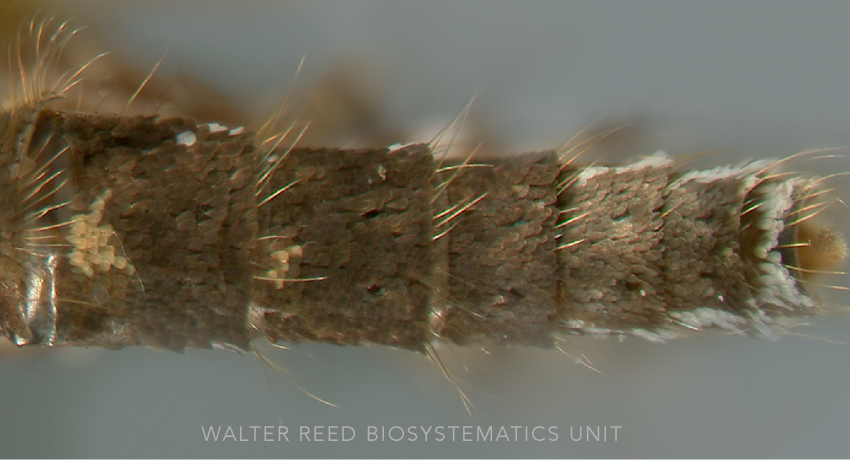AFROTROPICAL, AUSTRALASIAN, NEOTROPICAL, ORIENTAL & PALEARCTIC REGIONS
Generic abbreviation: Ma.
Type species: Culex titillans Walker
Etymology: Patrick Manson
Mansonia adults are differentiated from all other mosquitoes by the presence of their unique broad, asymmetrical scales on the wings, that are mixed dark and pale. Most speciose in tropical regions, a few species are also found in northern regions, e.g., Ma. dyari Heinemann & Page and Ma. titillans (Walker) occur in central and southern United States. The genus Mansonia comprises 25 valid species subdivided into two geographically distinct subgenera—Mansonia (15 Old World species) and Mansonioides (ten New World species).
DIAGNOSTIC CHARACTERS (Click photos to view; mouse over and click large photo to zoom in.)
ADULT (illustrated): Head: Clypeus bare, nearly as broad as long. Thorax: Postspiracular setae present. Legs: All Fe and Ti dark, speckled with pale scales; unguis (U-I–III) simple; pulvilli absent. Wing: Scales broad and asymmetrical, dark and pale scales intermixed. Abdomen: VIII-Te distinctly modified with short, robust hook-like setae; IX-Te poorly developed and lightly sclerotized; apex blunt in females; cercus well-developed, curved upward; two large spermathecae, with third absent or very small.
LARVA (not illustrated): Head: Antenna length about equal to head width; head with a prominent pointed projection under base of antenna. Terminal segments: Spiracular apparatus modified for piercing plant tissues; segment X with multiple sharply-pointed, stout precratal setae.
TAXONOMIC KEYS
Belkin et al. 1970 (Jamaica)
Clark-Gil & Darsie 1983 (Guatemala)
Cova-García et al. 1966 (Venezuela)
Darsie 1985 (keys; Argentina)
Forattini 1965 (Neotropics)
Lane 1953 (Neotropics)
Rattanarithikul & Harrison et al. 2005 (Thailand)
Rattanarithikul & Panthusiri 1994 (Thailand)
Ronderos & Bachmann 1963 (Neotropics)
![]()
WRBU – Genera – Global – Larva
![]()
WRBU – Genera – Afrotropical – Adult
![]()
WRBU – Genera – Afrotropical – Larva
![]()
WRBU – Mansonia – Afrotropical – Adult
![]()
WRBU – Mansonia – Afrotropical – Larva
![]()
WRBU – Genera – Australasia – Adult
![]()
WRBU – Genera – Australasia – Larva
![]()
WRBU – Mansonia – Australasia – Adult
![]()
WRBU – Mansonia – Australasia – Larva
![]()
WRBU – Genera – IndoMalaya – Adult
![]()
WRBU – Genera – IndoMalaya – Larva
![]()
WRBU – Mansonia – IndoMalaya – Adult
![]()
WRBU – Mansonia – IndoMalaya – Larva
![]()
WRBU – Genera – Oriental – Adult
![]()
WRBU – Genera – Oriental – Larva
![]()
WRBU – Mansonia – Oriental – Adult
![]()
WRBU – Mansonia – Oriental – Larva
![]()
WRBU – Genera – Eastern Palearctic – Adult
![]()
WRBU – Genera – Eastern Palearctic – Larva
![]()
WRBU – Genera – Western Palearctic – Adult
![]()
WRBU – Genera – Western Palearctic – Larva
![]()
WRBU – Genera – Nearctic – Adult
![]()
WRBU – Genera – Nearctic – Larva
![]()
WRBU – Genera – Neotropical – Adult
![]()
WRBU – Genera – Neotropical – Larva
Exemplar DNA sequences
Ma. (Man.) flaveola COI: JX260705, JX260065
Ma. (Man.) indubitans COI: MH118158
Ma. (Man.) titillans COI: KY859898–902
Ma. (Mnd.) africana COI: KU380478–79
Ma. (Mnd.) annulata COI: HQ341635–42
Ma. (Mnd.) annulifera COI: KX816503–11
Ma. (Mnd.) bonneae COI: KX816475–85
Ma. (Mnd.) dives COI: KX816465–74
Ma. (Mnd.) indiana COI: KX816496–502
Ma. (Mnd.) uniformis COI: KX816486–96
BIONOMICS
Immatures
Female Mansonia lay their eggs in star-shaped clusters on the underside of floating leaves, using specially adapted hook-like setae on their abdomens. Typical immature habitats include large, permanent water bodies—ponds and lakes with dense amounts of floating water hyacinth (Eichornia crassipes) or water lettuce (Pistia stratiotes). Immatures attach to, and respire through, the roots and stems of these aquatic plants using modified siphons. The species are so closely linked to their host plants, herbicidal treatments on the aquatic vegetation are often the most effective method of Mansonia population control.
Adults
Mansonia females are strong flyers, and can be found several miles away from their preferred immature habitats, seeking blood meals at dawn and dusk from a variety of birds, mammals (including people), and reptiles. Alligator blood was recovered from both Ma. dyari and Ma. titillans in Florida, United States. Certain species are fearsome biters and can become a local nuisance.
*Associated pathogens: This list reports bacteria, viruses, and parasites recovered from, or experimentally passed through this species, and does not imply field vector status.
IMPORTANT REFERENCES (full citations below)
Ronderos & Bachmann 1963a: 46 (generic group revision; Neotropical Region)
Gillett 1949 (key; Ethiopian Region)
Wharton 1962 (Malaysia)
Lane 1953 (as subgenus Rhynchotaenia of Coquillettidia; Neotropical Region)
Belkin 1962 (tax.; South Pacific)
Ronderos & Bachmann 1963 (descriptions, keys; Neotropics)
Forattini 1965 (Neotropical Region)
Cova-García et al. 1966 (Venezuela)
Delfinado 1966a (Philippines)
Belkin et al. 1970 (Jamaica)
Tanaka et al. 1979 (Japan, Korea)
Danilov 1983a (taxonomic key)
Darsie 1985 (keys; Argentina)
Lee et al. 1988b (Australasian Region)
Service 1990 (Afrotropical Region)
Rattanarithikul & Panthusiri 1994 (keys; Thailand)
Rattanarithikul & Harrison et al. 2005 (F, L; taxonomic keys, bionomics; Thailand)
VALID SUBGENERA
Mansonia Blanchard [Man.]
Mansonioides Theobald [Mnd.]
CURRENT GENERIC SYNONYMS
syn. Panoplites Theobald 1900a: 261 (as genus). (Theobald 1900a: 5 (not Gould 1853)). Type species: Culex titillans Walker 1848 (Blanchard 1901: 1046).
syn. Mansonia Blanchard 1901: 1046 (as genus and subgenus; new name for Panoplites Theobald). Type species: Culex titillans Walker 1848. On Official List of Generic Names in Zoology, ICZN 1959c (Opinion 550 protects generic name Mansonia Blanchard).
CITED REFERENCES
Belkin, J.N. (1962). The mosquitoes of the South Pacific (Diptera, Culicidae) (Vols. 1 &2). Berkeley, California: University of California Press.
Belkin, J.N., Heinemann, S.J., & Page, W.A. (1970). The Culicidae of Jamaica (Mosquito studies. XXI). Contributions of the American Entomological Institute, 6(1), 458.
Blanchard, R. (1901). Observations sur quelques moustiques. Comptes Rendus des Seances de la Société de Biologie, 53, 1045–1046.
Cova García, P., Sutil Oramas, E., & Rausseo, J.A. (1966). Mosquitos (Culicinos) de Venezuela. vol. I. [adults], vol. II. [larvae]. Ministerio de Sanidad y Asistencia Social, Caracas, 410pp.
Danilov, V.N. (1983a). A key for the mosquitoes of the genus Mansonia of the Afrotropical Region (Diptera: Culicidae). Anais do Instituto de Hygiene e Medicina Tropical (Lisbon), 9, 31–36.
Darsie, R.F., Jr. (1985). Mosquitoes of Argentina. Part I. Keys for identification of adult females and fourth stage larvae in English and Spanish (Diptera, Culicidae). Mosquito Systematics, 17(3), 153-23–253.
Delfinado, M.D. (1966a). The culicine mosquitoes of the Philippines, tribe Culicini (Diptera, Culicidae). Memoirs of the American Entomological Institute, 7, 1–252.
Forattini, O.P. (1965). Entomología Médica. 3.0 Volume. Culicini: Haemagogus, Mansonia, Culiseta, Sabethini, Toxorhynchitini. Arboviruses. Filariose bancroftiana. São Paulo: Universidade de São Paulo.
Gillett, J.D. (1949). Further notes on the Ethiopian species of Taeniorhynchus Arribalzaga (Diptera, Culicidae). Proceedings of the Royal Entomological Society (B), 18, 97–102.
Lane, J. (1953). Neotropical Culicidae (Vols. I, II). São Paulo: University of São Paulo.
Lee, D.J., Hicks, M.M., Debenham, M.L., Griffiths, M., Bryan, J.H., & Marks, E.N. (1988b). The Culicidae of the Australasian region. Volume 9. Commonwealth Department of Health, School of Public Health and Tropical Medicine Monograph Series, 2.
Rattanarithikul, R., & Panthusiri, P. (1994). Illustrated keys to the medically important mosquitoes of Thailand. Southeast Asian Journal of Tropical Medicine and Public Health, 66(Supplement 1), 1.
Rattanarithikul, R., Harrison, B.A., Panthusiri, P., & Coleman, R.E. (2005). Illustrated keys to the mosquitoes of Thailand. I. Background; geographic distribution; lists of genera, subgenera, and species; and a key to the genera. Southeast Asian Journal of Tropical Medicine and Public Health, 36(1), 1–80.
Ronderos, R.A., & Bachmann, A.O. (1963a). A proposito del complejo Mansonia (Diptera-Culicidae). Revista de la Sociedad Entomologica Argentina, (1962) 25, 43–51.
Service, M.W. (1990). Handbook to the Afrotropical toxorhynchitine and culicine mosquitoes, excepting Aedes and Culex. British Museum (Natural History).
Tanaka, K., Mizusawa, K., & Saugstad, E.S. (1979). A revision of the adult and larval mosquitoes of Japan (including the Ryukyu Archipelago and Ogasawara Islands) and Korea (Diptera: Culicidae). Contributions of the American Entomological Institute, 16, 1–987.
Theobald, F.V. (1900a). Report on the collections of mosquitoes (Culicidae) received at the British Museum (Natural History) from various parts of the world in connection with the investigations into the causes of malaria, conducted by the Colonial Office and the Royal Society. Bulletin of the British Museum (Natural History) Entomology.
Walker, F. (1848). List of the specimens of dipterous insects in the collection of the British Museum. Part I. London: British Museum.
CITE THIS PAGE
Walter Reed Biosystematics Unit (Year). Mansonia genus page. Walter Reed Biosystematics Unit Website, http://wrbu.si.edu/vectorspecies/genera/mansonia, accessed on [date (e.g. 03 February 2020) when you last viewed the site].







